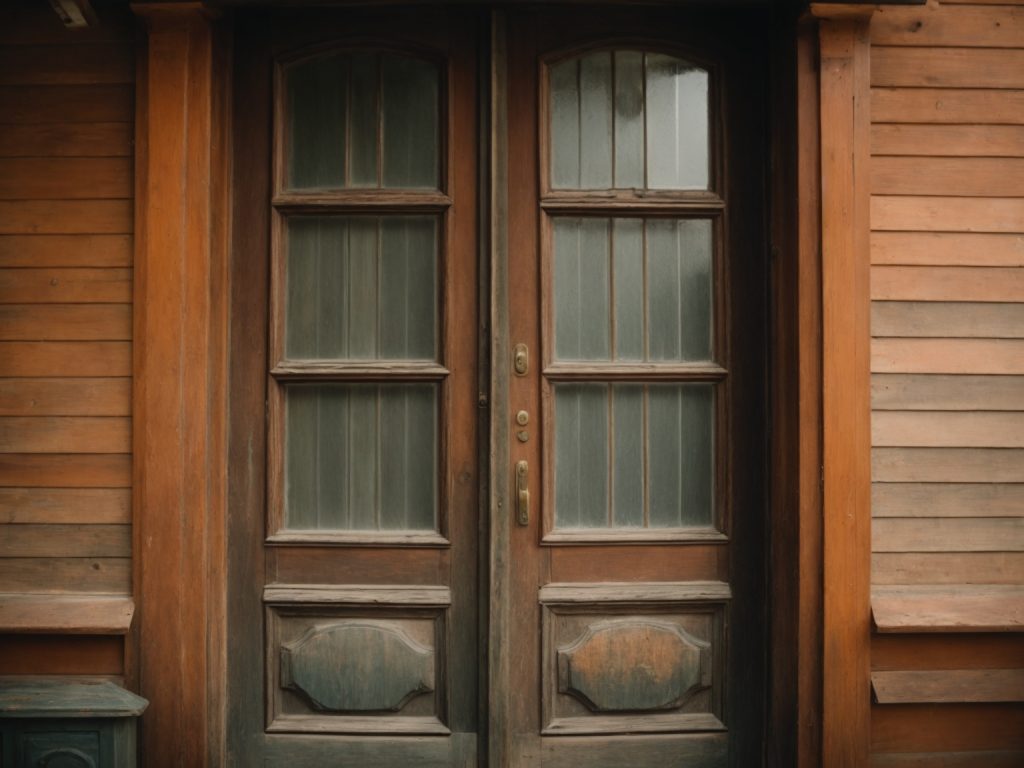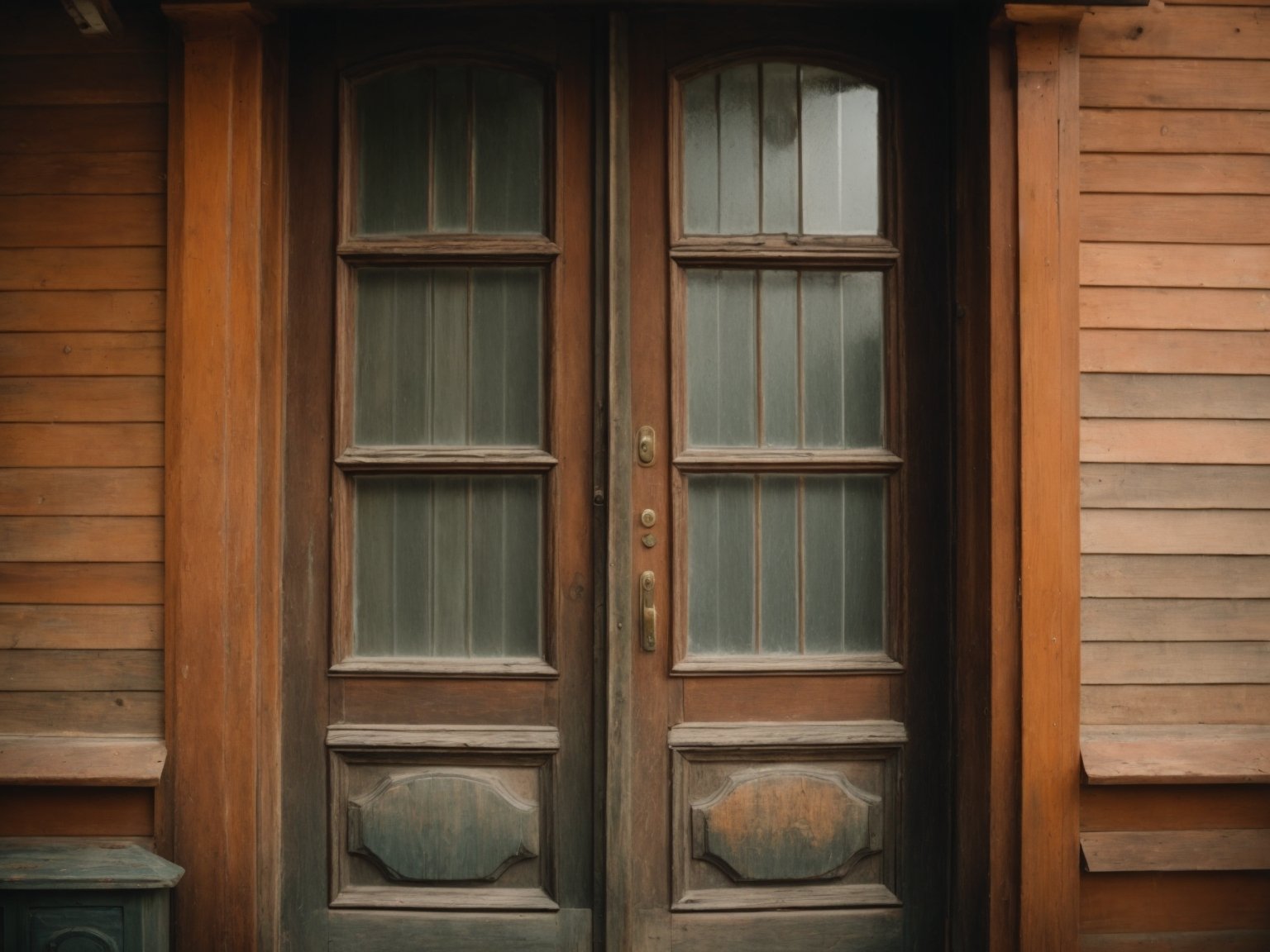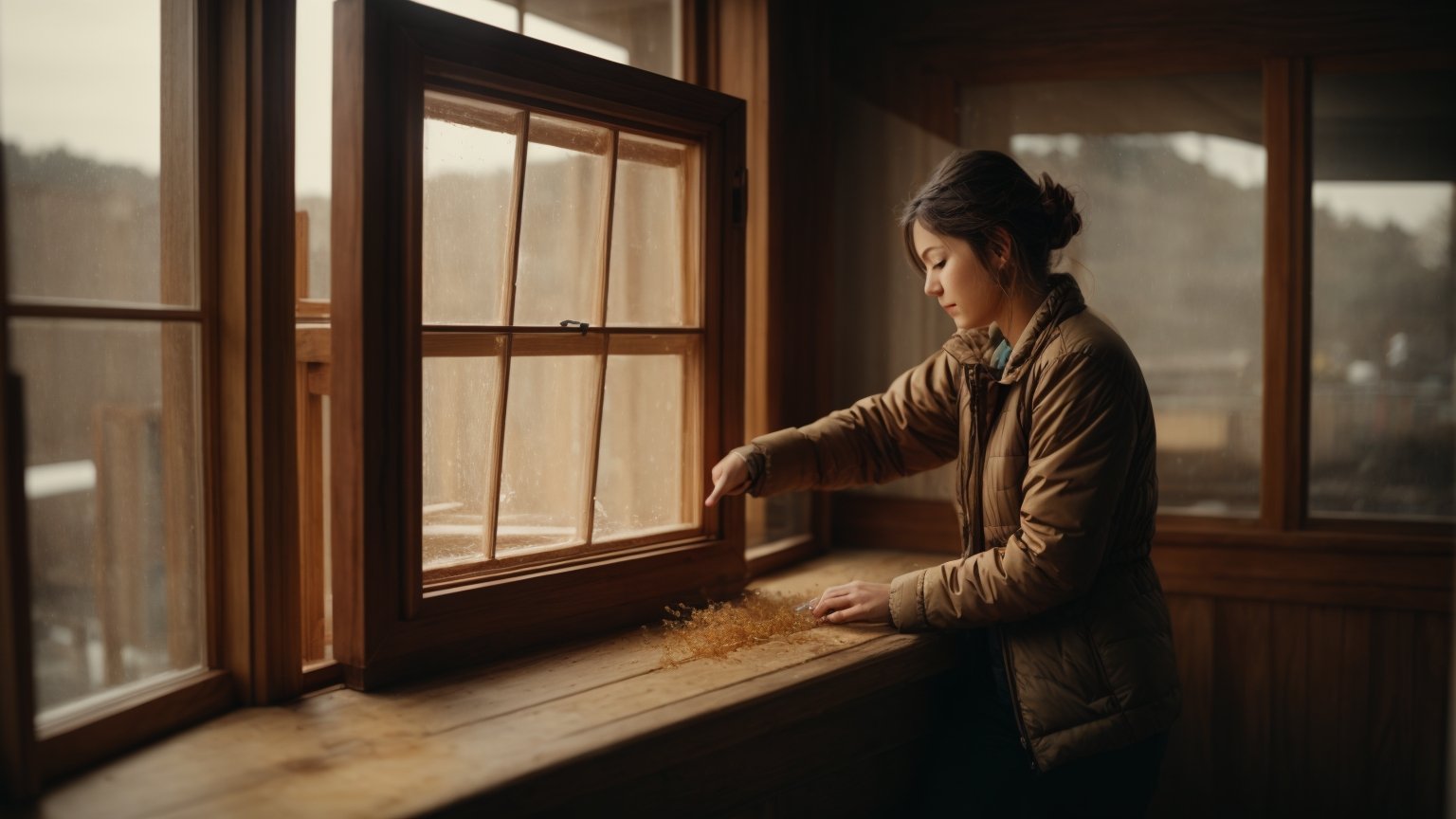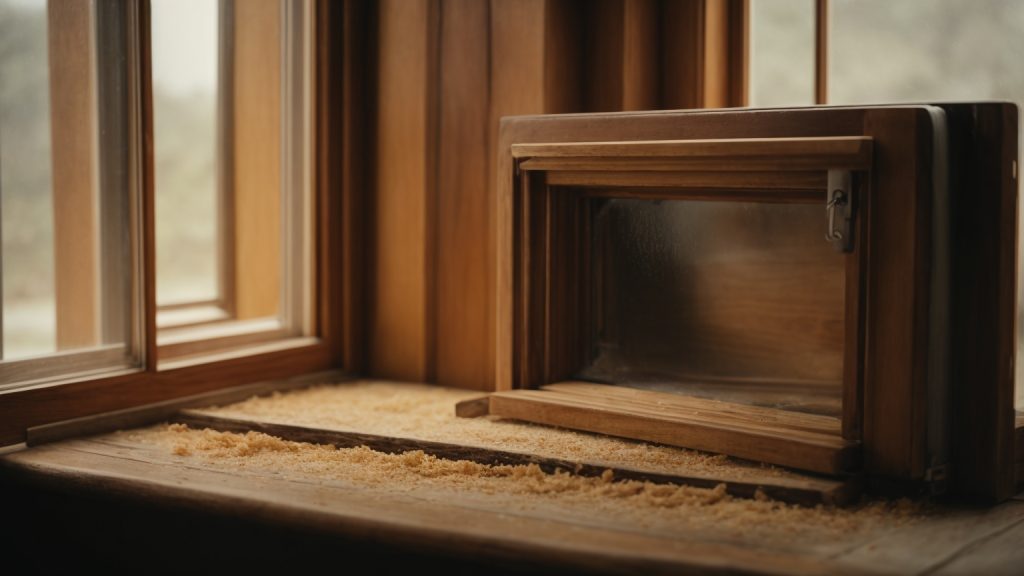Is your wooden front door looking weathered and worn? If so, you’re not alone. Over time, exposure to the elements can cause wood doors to fade, crack, and peel. However, there’s good news! Restoring a weathered wooden front door is a simple and affordable process that can breathe new life into your entryway.
One easy step to restore your weathered wood door is to use a product called Sun Shield. This product can help to restore the finish of your door, making it look like new again. Additionally, you can refinish your door by sanding it down with a random-orbit sander and applying a fresh coat of varnish. By following these simple steps, you can restore your weathered wooden front door and make a great first impression on your guests.
Understanding the Damage

If your wooden front door is looking weathered and worn, it’s important to understand the type of damage it has sustained before attempting to restore it. Here are some common types of damage that can occur:
Sun Damage
The sun’s UV rays can cause wood to dry out, fade, and crack over time. If your front door is exposed to direct sunlight for long periods of time, it’s likely that it has sustained sun damage.
Weather Damage
Rain, snow, and other types of weather can also take a toll on your front door. Moisture can cause wood to swell, warp, and rot, which can lead to structural damage over time.
Wear and Tear
Daily use can cause your front door to become scratched, dented, or chipped. This type of damage is usually cosmetic, but it can still detract from the overall appearance of your door.
Insect Damage
Termites and other wood-boring insects can cause serious damage to your front door over time. If you notice small holes or sawdust around your door, it’s possible that insects are present.
By understanding the type of damage your front door has sustained, you can choose the right restoration method and materials to bring it back to life.
Materials and Tools Needed
Restoring a weathered wooden front door is a simple DIY task that can be accomplished with a few basic tools and materials. Here’s what you’ll need:
Materials
- Sandpaper (80-grit, 100-grit, and 120-grit)
- Wood stain or paint
- Clear coat or sealant
- Rag or cloth
- Mineral spirits (if using oil-based products)
- Painter’s tape
Tools
- Random-orbit sander
- Paintbrush or foam roller
- Screwdriver
- Sawhorses or a sturdy work surface
- Drop cloth or tarp
Before you begin, make sure you have all the necessary materials and tools. You may already have some of them on hand, but if not, they can be easily found at your local hardware or home improvement store.
When choosing your materials, consider the type of wood your door is made of and the look you want to achieve. If you prefer a natural wood look, choose a stain that complements the wood’s natural color. If you prefer a painted finish, choose a high-quality paint that is designed for exterior use.
Using a clear coat or sealant will help protect your door from future weather damage and ensure that your hard work lasts for years to come.
Preparation of the Door
Before you start restoring your weathered wooden front door, you need to prepare it properly. Here are the steps you should follow:
- Remove the Door: The first thing you need to do is remove the door from its hinges. This will make it easier to work on the door and ensure that you don’t accidentally damage the surrounding area.
- Clean the Door: Use a soft-bristled brush or a cloth to remove any dirt, dust, or debris from the door. You can also use a vacuum cleaner with a soft brush attachment to remove the dirt from the nooks and crannies.
- Sand the Door: Use sandpaper to remove any loose or flaking paint, varnish, or stain from the door. Start with a coarse-grit sandpaper and then move to a finer-grit sandpaper to achieve a smooth surface. Be sure to sand with the grain of the wood.
- Repair Any Damage: If your door has any cracks, holes, or other damage, you need to repair it before you start restoring it. Use wood filler to fill any holes or cracks and then sand the area smooth.
- Apply a Stripper: If your door has a lot of old paint or varnish, you may need to use a paint stripper to remove it. Be sure to follow the manufacturer’s instructions and wear protective gloves and eyewear.
- Clean Again: Once you have stripped the door, you need to clean it again to remove any residue from the stripper. Use a cloth and a mild detergent to clean the door thoroughly.
By following these steps, you can prepare your weathered wooden front door for restoration.
Stripping the Old Paint
If your wooden front door is covered in old paint, it’s important to strip it off before refinishing the wood. Here are the steps you need to follow to strip the old paint off your front door.
Safety Measures
Before you start stripping the paint off your front door, it’s important to take some safety measures to protect yourself from the chemicals involved in the process. Here are some things you should do:
- Wear gloves and protective eyewear to protect your skin and eyes from the chemicals.
- Work in a well-ventilated area to avoid inhaling fumes.
- Cover the surrounding area with drop cloths to avoid getting paint stripper on anything else.
Process of Stripping
Here’s how to strip the old paint off your front door:
- Apply paint stripper to the door using a brush or roller. Be sure to follow the manufacturer’s instructions for the specific product you’re using.
- Wait for the paint stripper to work. This can take anywhere from a few minutes to several hours depending on the product and the thickness of the paint.
- Use a scraper to remove the paint. Be sure to scrape in the direction of the wood grain to avoid damaging the wood.
- Repeat steps 1-3 until all the paint is removed.
- Once all the paint is removed, use a fine-grit sandpaper to smooth out any rough spots.
Remember to dispose of the paint stripper and any paint chips in accordance with your local regulations. With the old paint stripped off, your front door is now ready for refinishing.
Sanding the Door
When restoring a weathered wooden front door, sanding is a crucial step to prepare the surface for refinishing. Here are some tips to help you sand your door effectively and efficiently.
Choosing the Right Sandpaper
Before starting, it’s important to choose the right sandpaper grit for your door. A lower grit sandpaper, such as 60 or 80, is best for removing old paint or finish. Once the old finish is removed, switch to a higher grit sandpaper, such as 120 or 150, to smooth out the surface and prepare it for refinishing.
Sanding Technique
When sanding your door, it’s important to use a consistent and even pressure. Sand with the grain of the wood to avoid creating scratches or marks on the surface. Use a sanding block or tool to ensure an even finish. Be sure to sand all areas of the door, including the edges and corners.
After sanding, use a tack cloth or a damp cloth to remove any dust or debris from the surface. This will ensure a smooth and even finish when refinishing your door.
Remember, sanding is a crucial step in restoring a weathered wooden front door. With the right sandpaper and technique, you can achieve a beautiful and long-lasting finish.
Addressing Weather Damage
If your wooden front door has been exposed to the elements for a long time, it can develop cracks, splits, and rot. These issues can make your door look unsightly and can even compromise its structural integrity. Fortunately, there are steps you can take to address these problems and restore your door to its former glory.
Fixing Cracks and Splits
If your door has developed cracks or splits, you can fix them using wood filler. Here’s how:
- Clean the damaged area with a stiff-bristled brush to remove any loose or splintered wood.
- Apply wood filler to the damaged area using a putty knife. Make sure to fill the crack or split completely.
- Smooth the surface of the wood filler with the putty knife.
- Allow the wood filler to dry completely, following the manufacturer’s instructions.
- Sand the surface of the wood filler with fine-grit sandpaper until it is smooth and flush with the surrounding wood.
- Apply a coat of primer to the repaired area to seal the wood filler and prepare it for paint or stain.
Treating Rotten Wood
If your door has developed rot, you will need to remove the affected wood and replace it with new wood. Here’s how:
- Use a screwdriver or chisel to remove any loose or rotten wood.
- Cut a piece of new wood to fit the area you removed.
- Apply wood glue to the edges of the new wood and the surrounding wood.
- Insert the new wood into the hole and press it firmly in place.
- Clamp the new wood in place and allow the glue to dry completely, following the manufacturer’s instructions.
- Sand the surface of the new wood until it is smooth and flush with the surrounding wood.
- Apply a coat of primer to the repaired area to seal the new wood and prepare it for paint or stain.
By following these steps, you can address weather damage to your wooden front door and restore its appearance and function.
Priming the Door
Now that you have cleaned and sanded your weathered wooden front door, it’s time to prime it. Priming the door is an essential step that will help the new paint or stain adhere better and last longer. Here are a few steps to follow when priming your door:
- Choose the right primer: There are many types of primers available, so make sure you choose the right one for your door. If you plan to stain your door, choose a wood conditioner or a clear primer. If you plan to paint your door, choose a primer that is compatible with the type of paint you will be using.
- Apply the primer: Using a brush or a roller, apply a thin and even coat of primer to the door. Make sure to apply the primer in the direction of the wood grain and avoid leaving any drips or brush marks. If you are using a spray primer, make sure to follow the manufacturer’s instructions and wear a mask to protect yourself from fumes.
- Let the primer dry: Allow the primer to dry completely before applying the paint or stain. The drying time will depend on the type of primer and the weather conditions, so make sure to check the label for instructions.
- Sand the primer: Once the primer is dry, use a fine-grit sandpaper to sand the surface of the door lightly. This will help smooth out any rough spots and create a better surface for the paint or stain to adhere to.
- Clean the door: Use a tack cloth or a damp cloth to remove any dust or debris from the surface of the door. Make sure the surface is clean and dry before applying the paint or stain.
By following these steps, you can ensure that your weathered wooden front door is properly primed and ready for the final coat of paint or stain.
Painting the Door
If you want to restore your weathered wooden front door, painting it is a great option. Here are some tips to help you get started.
Choosing the Right Paint
When choosing a paint for your front door, it’s important to select an exterior-grade paint that can withstand the elements. Look for a paint that is specifically designed for use on wood and offers UV protection to prevent fading from the sun.
Consider the color of your door and the style of your home when selecting a paint color. A bright color can add a pop of personality to your home, while a more neutral color can create a classic look.
Painting Technique
Before you start painting, make sure your door is clean and dry. Sand any rough spots or peeling paint to create a smooth surface.
Apply a primer to the door to help the paint adhere and create a more even finish. Once the primer is dry, apply the paint in thin, even coats. It’s better to apply multiple thin coats than one thick coat, which can lead to drips and an uneven finish.
Use a high-quality brush or roller to apply the paint, and work in the direction of the wood grain. Be sure to paint the edges of the door as well.
Allow each coat of paint to dry completely before applying the next coat. Once you’re happy with the coverage, allow the final coat to dry for at least 24 hours before reattaching any hardware or closing the door.
By following these tips, you can restore your weathered wooden front door with a fresh coat of paint.
Maintaining Your Restored Door
Once you’ve restored your weathered wooden front door, it’s important to maintain it properly to keep it looking beautiful and protect it from the elements. Here are some tips for maintaining your restored door:
Regular Cleaning
Regular cleaning is essential to keep your door looking great. Here’s what you need to do:
- Use a soft cloth or sponge to wipe down the door with warm, soapy water. Avoid using harsh chemicals or abrasive materials, as these can damage the finish.
- Rinse the door thoroughly with clean water and dry it with a soft towel.
- If your door has glass panels, clean them with a glass cleaner and a soft cloth.
Annual Check-up
It’s a good idea to give your door an annual check-up to make sure it’s still in good condition. Here’s what you need to do:
- Inspect the door for any signs of wear or damage, such as cracks, chips, or peeling paint. If you notice any problems, address them as soon as possible to prevent further damage.
- Check the weatherstripping around the door to make sure it’s still in good condition. Replace any worn or damaged weatherstripping to keep your home energy-efficient.
- Lubricate the hinges and locks with a silicone-based lubricant to keep them working smoothly.
By following these simple maintenance tips, you can keep your restored wooden front door looking beautiful for years to come.






